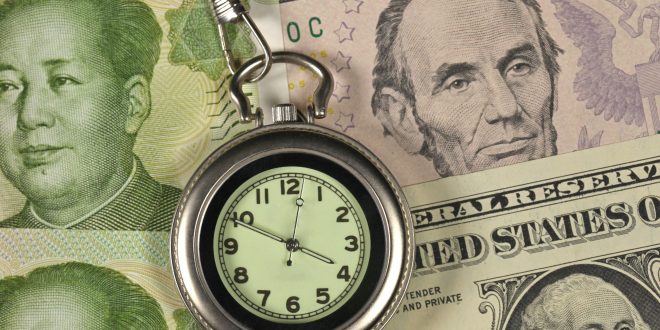The U.S.
Last week, the U.S. stock market continued its upward trajectory, inching closer to record highs amid light trading volumes. The S&P 500 Index notched its third consecutive week of gains, nearing its all-time peak. While the broader market advanced, the spotlight was on value stocks, which outpaced growth shares.
Market activity remained subdued for much of the week, characterized by notably low trading volumes. Wednesday marked the year’s lowest session, with trading volumes hitting their third-lowest levels of the year. This quietude mirrored the economic landscape, which offered little surprise or upheaval. However, individual stocks experienced sharp movements in response to first-quarter earnings releases.
Notably, Walt Disney shares plummeted 9.5% after the company surpassed earnings estimates but cautioned about potential slowdowns in subscriber growth for its online streaming platform. Similarly, Shopify saw an 18.6% decline following forecasts of decelerating revenue growth.
The labor market grabbed investors’ attention as weekly jobless claims unexpectedly rose to their highest level since August, reaching 231,000. Continuing claims also reversed a downward trend, climbing to 1.79 million. Concerns deepened with the University of Michigan’s consumer sentiment index plummeting to 67.4, its lowest in six months. Consumers voiced worries about inflation, unemployment, and interest rates, signaling potential headwinds for the economy.
In the bond market, the yield on the 10-year U.S. Treasury note remained relatively stable, with bond prices experiencing minimal fluctuations. Despite heavy primary issuance, tax-exempt municipal bonds rallied alongside Treasuries, buoyed by robust demand from both retail and institutional investors. Investment-grade corporate bonds also saw healthy demand despite a surge in new issuance, indicating growing investor confidence. Sentiment in the high yield bond market improved as equities posted gains throughout the week.
As the financial markets navigate through evolving economic indicators and corporate earnings reports, investors remain cautiously optimistic, mindful of potential headwinds on the horizon.
Europe
Last week witnessed a surge in European markets, driven by upbeat corporate earnings and growing optimism surrounding potential interest rate cuts by major central banks. In local currency terms, the pan-European STOXX Europe 600 Index soared by 3.01%, propelled by robust performances across major stock indexes.
Germany’s DAX led the charge, advancing by 4.28%, closely followed by France’s CAC 40 Index, which gained 3.29%. Italy’s FTSE MIB also joined the rally, adding 3.06%, while the UK’s FTSE 100 Index climbed 2.68% to reach a new record high.
Amidst this market exuberance, the Bank of England (BoE) stood firm on its key interest rate, maintaining it at 5.25%. However, signals emerged indicating a potential shift towards policy easing, with Deputy Governor Dave Ramsden and Swati Dhingra voting for a rate cut of 0.25%. BoE Governor David Bailey hinted at the possibility of more significant rate reductions, contingent upon forthcoming economic data. The BoE revised its inflation forecasts downward, projecting a sharper slowdown to 1.9% in 2026 and 1.6% in 2027.
In a separate development, the UK economy defied expectations, expanding by a robust 0.6% in the first quarter of 2024, thus breaking free from the recessionary grip that took hold in the latter half of the previous year. Growth was underpinned by expansions in the services sector and increased production.
Meanwhile, Sweden’s central bank, the Riksbank, took proactive measures by lowering its key interest rate by a quarter point to 3.75%, marking its first rate cut since 2016. The decision was motivated by concerns over slowing inflation, with the Riksbank suggesting the potential for two additional rate cuts in the latter half of the year, contingent upon the inflation outlook.
As European markets navigate a landscape marked by shifting central bank policies and economic recoveries, investors remain vigilant, closely monitoring data releases and policy announcements for further cues on market direction.
Japan and Yen
Last week, Japan’s Nikkei 225 Index and the broader TOPIX Index experienced marginal losses against a backdrop of nuanced commentary from Bank of Japan (BoJ) Governor Kazuo Ueda. Ueda hinted at the possibility of early interest rate hikes should upside risks to the price outlook materialize, particularly in light of the yen’s vulnerability to weakness. Despite prevailing high U.S.-Japan interest rate differentials, some analysts question whether further rate hikes would foster sustainable yen appreciation.
The yen’s depreciation persisted throughout the week, reaching the high-JPY 157 range against the USD, a decline from approximately 153. This occurred despite speculation that authorities had intervened in foreign exchange markets to bolster the yen, as hinted at by the BoJ’s accounts.
Amidst these currency dynamics, the yield on the 10-year Japanese government bond remained largely unchanged, hovering around the 0.9% mark, near a six-month high. Insights gleaned from the BoJ’s April meeting reflected a notable hawkish sentiment among participants, with discussions indicating a potential acceleration in monetary policy normalization. Some participants even suggested that market expectations for interest rates might be lower than warranted, with many foreseeing the possibility of two rate hikes within a year.
However, Japan’s economic data revealed pockets of weakness that could impede the BoJ’s rate hike agenda. Real wages, adjusted for inflation, plummeted by 2.5% in March compared to the previous year, exacerbating the 1.8% drop recorded in the prior month. The BoJ continues to emphasize the importance of a “virtuous cycle” where price growth, accompanied by wage inflation, fuels economic momentum toward its 2% target. Although the central bank has terminated its negative interest rate policy, its current monetary stance remains one of the most accommodative globally.
As Japan’s central bank navigates the delicate balance between stimulating economic growth and addressing inflationary pressures, market participants closely monitor policy signals and economic indicators for insights into the future trajectory of monetary policy.
Gold
Gold prices experienced a notable surge late in the North American session on Friday, climbing by more than 1% despite U.S. Treasury bond yields maintaining high levels. The rise coincided with a University of Michigan (UoM) survey revealing a significant downturn in consumer sentiment, plunging to its lowest level in six months.
The XAU/USD pair traded at $2,369 after rebounding from daily lows of $2,343. The latest sentiment data, coupled with weaker labor market figures reported since the beginning of May, painted a gloomy picture of the U.S. economy. While concerns about a severe economic slowdown remained relatively low, investors seeking safety flocked to both gold and the U.S. Dollar, driving prices higher.
Federal Reserve officials remained in the spotlight, offering contrasting views on monetary policy. Atlanta Fed President Raphael Bostic maintained a hawkish stance, suggesting that the Fed is likely to implement only one rate cut in 2024. Conversely, Fed Governor Michelle Bowman emphasized the need for policy stability and dismissed the possibility of rate cuts this year. Dallas Fed’s Lorie Logan echoed similar sentiments, refuting the idea of interest rate reductions.
Looking ahead, the U.S. economic calendar for the upcoming week will feature the release of inflation figures, retail sales data, building permits statistics, and speeches from Federal Reserve officials. These events are expected to provide further insights into the trajectory of monetary policy and market sentiment.
Oil
Last Friday, oil prices experienced a notable decline of nearly $1 per barrel following remarks from U.S. central bank officials hinting at the possibility of sustained higher interest rates. Brent crude futures settled at $82.79 per barrel, marking a decrease of $1.09, or 1.3%, while U.S. West Texas Intermediate crude settled at $78.26 per barrel, down $1.00, or 1.3%.
Throughout the week, Brent crude registered a marginal 0.2% loss, while WTI managed a modest 0.2% increase.
Dallas Federal Reserve President Lorie Logan underscored uncertainty regarding whether current monetary policy measures were sufficiently tight to curb inflation to the central bank’s 2% target. Higher interest rates typically correlate with decreased economic activity and reduced oil demand.
Adding to this sentiment, Atlanta Fed President Raphael Bostic expressed his belief that inflation was likely to decelerate under existing monetary policy, potentially paving the way for the central bank to initiate rate cuts in 2024, albeit tentatively and possibly by only a quarter of a percentage point toward the end of the year.
The U.S. dollar strengthened following these statements, rendering dollar-denominated commodities, including oil, more expensive for buyers using other currencies. The prospect of prolonged higher U.S. interest rates also raised concerns about dampened demand.
Looking ahead, U.S. inflation data scheduled for release next week could further influence Federal Reserve decisions on interest rates.
Despite the decline in oil prices, the U.S. oil rig count, an indicator of future supply, showed little impact. Energy services firm Baker Hughes reported a decrease of three oil rigs to 496, the lowest count since November.
Meanwhile, money managers reduced their net long U.S. crude futures and options positions by 56,517 contracts to 82,697 in the week ending May 7, according to the U.S. Commodity Futures Trading Commission.
China’s April oil import data, which exceeded last year’s figures, provided some support to oil prices, as did news of China’s rebounding exports and imports after a previous month of contraction.
In Europe, tensions escalated as a Ukrainian drone attack ignited an oil refinery in Russia’s Kaluga region, as reported by RIA state news agency. Additionally, conflict persisted in the Middle East, with Israeli forces targeting areas of southern Gaza city of Rafah on Thursday, according to Palestinian residents, amid stalled negotiations to halt hostilities in Gaza.
Cryptocurrency
Last Friday, Bitcoin exhibited a modest uptick, marking a slight rebound from recent losses, as traders maintained caution amidst soft U.S. labor data and looming concerns over regulatory actions in the cryptocurrency space. The dollar’s decline following lackluster labor figures lent some support to Bitcoin, which traded up 3.5% over the preceding 24 hours at $63,243.4.
Fears of intensified regulatory scrutiny weighed heavily on cryptocurrency markets throughout the week, fueled by reports of impending actions by the U.S. Securities and Exchange Commission (SEC) against major players in the crypto sphere. The closure of a prominent privacy coin trading platform further exacerbated market sentiment.
Despite the recent rebound, Bitcoin’s performance over the past week remained largely unchanged, residing within a trading range established since its descent from record highs in early March. The cryptocurrency had dipped as low as $57k the prior week, signaling a technical bear market from its March peaks.
Ongoing regulatory concerns stifled any significant upward momentum, with the SEC delaying the public listing of crypto wallet operator Exodus Movement and reportedly investigating various aspects of the crypto market, including spot Ethereum ETFs and the classification of Ethereum as a security.
The broader cryptocurrency market saw mixed movements, with Ethereum rising 1.9%, XRP climbing 0.3%, and Solana outperforming with an over 8% increase.
Dogecoin (DOGE), the renowned meme cryptocurrency, showcased signs of repeating a bullish “golden cross” technical pattern reminiscent of its early 2021 surge. With a market capitalization of approximately $22 billion, DOGE has exhibited remarkable performance this year, surpassing Bitcoin’s gains by surging over 70%.
CoinDesk reported that DOGE’s 50-week simple moving average (SMA) is on an upward trajectory, poised to intersect the 200-week SMA in the near future, signaling a golden cross. This pattern historically precedes significant bullish movements in the cryptocurrency.
While weak jobless claims data fueled speculations of potential interest rate cuts by the Federal Reserve, such actions are not anticipated until September, exerting short-term pressure on crypto markets. The regulatory landscape remains a focal point for market participants, shaping sentiment and driving volatility in the cryptocurrency space.
China
Last week, Chinese equities surged as optimism surrounding economic recovery swelled, buoyed by robust holiday spending during the Labor Day holiday the previous week. The Shanghai Composite Index rallied by 1.6%, while the blue-chip CSI 300 index recorded a gain of 1.72%. In Hong Kong, the benchmark Hang Seng Index added 2.64%, according to FactSet data.
Holiday spending provided a significant boost, with tourism revenue during the five-day break soaring by 7.6% compared to the same period in 2023, surpassing pre-pandemic levels. Domestic revenue surged by 12.7% year-on-year, while international travel also showed signs of recovery. Despite the overall uptick in revenue, average spending per traveler dipped by 11.5% compared to 2019 levels, reflecting lingering consumer caution amid economic uncertainties.
In economic indicators, the private Caixin/ S&P Global survey of services activity for April posted a reading of 52.5, slightly down from March’s 52.7 but still signaling expansion for the 16th consecutive month. Similarly, the Caixin/ S&P composite purchasing managers’ index, which tracks both services and manufacturing sectors, edged up to 52.8 from 52.7 in March, indicating overall business activity growth in April.
China’s trade data exceeded expectations, with exports rebounding by 1.5% in April compared to the previous year, a significant improvement from March’s 7.5% decline. Exports to Southeast Asian countries saw notable gains, while shipments to Europe experienced a downturn. Sales to the U.S. remained relatively stable. Import figures also impressed, rising by 8.4% in April, a turnaround from March’s 1.9% drop. Analysts attributed this increase to heightened shipments of raw materials rather than a surge in consumer demand. The trade surplus widened to USD 72.35 billion, up from USD 58.55 billion in March.
As China’s economy continues its path to recovery, supported by resilient consumer spending and improving trade figures, investors remain cautiously optimistic about the country’s growth prospects amidst global economic uncertainties.
Upcoming Events in the Financial Markets: Next Week’s Outlook
UK Jobs Report (Tuesday): Analysts anticipate the unemployment rate for the 3-month period ending in March to rise slightly to 4.3%, while headline wages are expected to dip to 5.5% from 5.6%. The prior report saw unexpected increases in the unemployment rate and declines in employment, with notable fluctuations in regular pay. Focus will be on wage growth and its potential impact on policy decisions, particularly regarding expectations for a June rate cut.
US CPI (Wednesday): Headline CPI is projected to rise by 0.3% month-on-month in April, with core inflation also expected to increase by 0.3%, cooling from the previous month. Despite recent upticks in inflation, Fed Chair Powell has ruled out immediate interest rate hikes, suggesting a longer-term approach to address inflation concerns. Analysts view a CPI rise of 0.3% as potentially delaying rate cuts, reinforcing expectations for the Fed to maintain current interest rate levels for an extended period.
US Retail Sales (Wednesday): Headline retail sales are forecasted to rise by 0.4% month-on-month in April, with the core rate expected to increase by 0.2%. Consumer spending and wage momentum, particularly among lower-income cohorts, have shown resilience, albeit against a backdrop of rising property insurance costs. While lower-income spending growth remains robust, concerns persist regarding potential impacts on spending momentum due to labor market fluctuations and increased debt payments.
As markets await these key data releases, investors will closely monitor economic indicators for insights into future policy decisions and market sentiment.
 Noor Trends News, Technical Analysis, Educational Tools and Recommendations
Noor Trends News, Technical Analysis, Educational Tools and Recommendations





